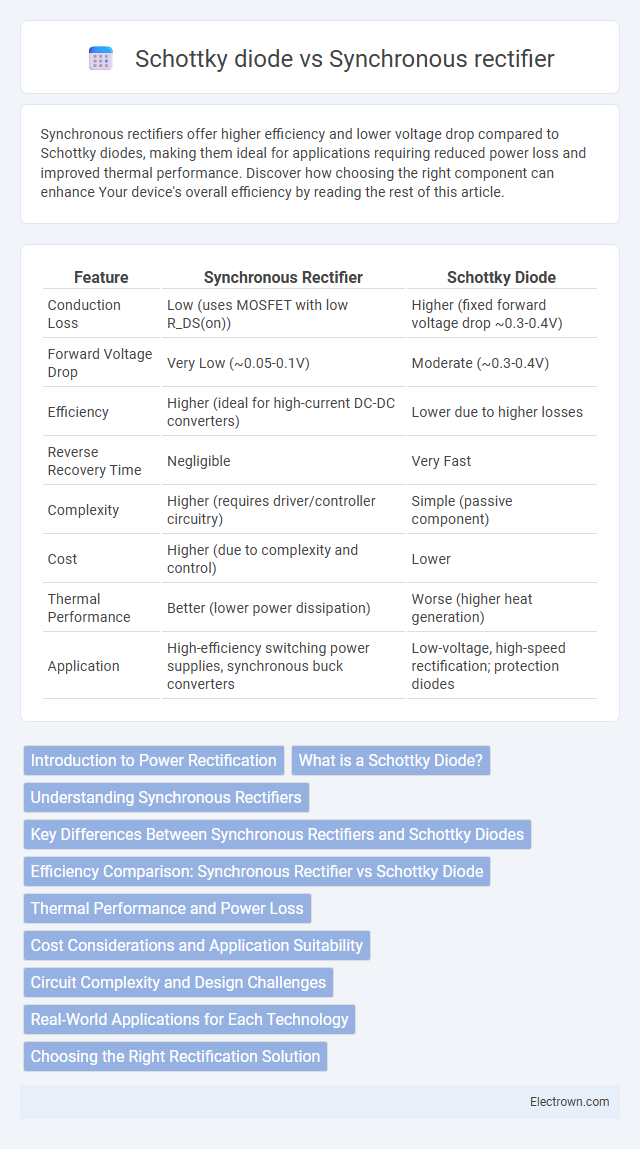Synchronous rectifiers offer higher efficiency and lower voltage drop compared to Schottky diodes, making them ideal for applications requiring reduced power loss and improved thermal performance. Discover how choosing the right component can enhance Your device's overall efficiency by reading the rest of this article.
Table of Comparison
| Feature | Synchronous Rectifier | Schottky Diode |
|---|---|---|
| Conduction Loss | Low (uses MOSFET with low R_DS(on)) | Higher (fixed forward voltage drop ~0.3-0.4V) |
| Forward Voltage Drop | Very Low (~0.05-0.1V) | Moderate (~0.3-0.4V) |
| Efficiency | Higher (ideal for high-current DC-DC converters) | Lower due to higher losses |
| Reverse Recovery Time | Negligible | Very Fast |
| Complexity | Higher (requires driver/controller circuitry) | Simple (passive component) |
| Cost | Higher (due to complexity and control) | Lower |
| Thermal Performance | Better (lower power dissipation) | Worse (higher heat generation) |
| Application | High-efficiency switching power supplies, synchronous buck converters | Low-voltage, high-speed rectification; protection diodes |
Introduction to Power Rectification
Power rectification converts alternating current (AC) to direct current (DC) using devices like synchronous rectifiers and Schottky diodes, critical for efficient power supply design. Synchronous rectifiers utilize MOSFETs controlled by timing signals, significantly reducing conduction losses compared to conventional Schottky diodes known for their low forward voltage drop and fast switching capabilities. Selecting between these rectification methods depends on factors like efficiency, cost, and thermal performance in applications such as DC-DC converters and power management systems.
What is a Schottky Diode?
A Schottky diode is a semiconductor device known for its low forward voltage drop and fast switching speed, making it ideal for high-frequency applications and power rectification. Its metal-semiconductor junction differs from the p-n junction in traditional diodes, resulting in reduced power loss and improved efficiency. Understanding the characteristics of a Schottky diode can enhance your design choices in circuits requiring efficient rectification and low noise.
Understanding Synchronous Rectifiers
Synchronous rectifiers utilize MOSFETs instead of traditional diodes to achieve significantly lower voltage drops and improve efficiency in power conversion circuits. Unlike Schottky diodes, which offer low forward voltage and fast switching, synchronous rectifiers actively control the conduction path, reducing conduction losses especially at high currents. This technology is critical in applications such as DC-DC converters and power supply units where maximizing energy efficiency and thermal performance is essential.
Key Differences Between Synchronous Rectifiers and Schottky Diodes
Synchronous rectifiers use MOSFETs to achieve lower conduction losses and higher efficiency in power conversion compared to Schottky diodes, which rely on semiconductor junctions with inherently higher forward voltage drops. Synchronous rectification enables better thermal performance and smaller heat sinks due to reduced power dissipation, making it suitable for high-current applications, whereas Schottky diodes are simpler, faster, and more robust for low-voltage, low-power circuits. The key difference lies in synchronous rectifiers being active switching devices controlled by a driver circuit, whereas Schottky diodes are passive components relying on their material properties for rectification.
Efficiency Comparison: Synchronous Rectifier vs Schottky Diode
Synchronous rectifiers offer higher efficiency than Schottky diodes due to their lower conduction losses, especially in low-voltage, high-current applications. Unlike Schottky diodes, which have a fixed forward voltage drop around 0.3V to 0.4V, synchronous rectifiers use MOSFETs with on-resistance that can be significantly lower, reducing power dissipation and heat generation. Your power supply design can benefit from improved efficiency and reduced thermal management requirements when opting for synchronous rectification over Schottky diodes.
Thermal Performance and Power Loss
Synchronous rectifiers offer superior thermal performance compared to Schottky diodes by reducing conduction losses through active MOSFET switching, which minimizes heat generation in power conversion circuits. Power loss is significantly lower in synchronous rectifiers due to their lower forward voltage drop, enhancing energy efficiency and enabling improved thermal management in high-current applications. Your power supply design benefits from reduced thermal stress and improved overall efficiency when choosing synchronous rectifiers over Schottky diodes for rectification tasks.
Cost Considerations and Application Suitability
Synchronous rectifiers typically have higher initial costs due to their complexity and need for control circuitry, but offer significant efficiency gains in high-current, low-voltage applications, making them ideal for power supplies and DC-DC converters. Schottky diodes present a lower-cost solution with simpler design and faster switching speeds, suitable for low to moderate current applications where efficiency is less critical. Cost-effectiveness depends on the balance between power loss savings and upfront expenses, with synchronous rectifiers favored in energy-sensitive designs and Schottky diodes chosen for budget-conscious or simpler circuits.
Circuit Complexity and Design Challenges
Synchronous rectifiers involve more circuit complexity and design challenges compared to Schottky diodes due to the need for precise timing control and gate drive circuitry to switch MOSFETs efficiently. This increased complexity demands careful layout and control algorithms to prevent shoot-through and minimize switching losses, impacting overall system reliability. Your power converter design must balance these factors against the improved efficiency that synchronous rectifiers offer over Schottky diodes.
Real-World Applications for Each Technology
Synchronous rectifiers are commonly used in high-efficiency power supplies and DC-DC converters for computers, smartphones, and electric vehicles due to their low conduction losses and improved thermal performance. Schottky diodes excel in low-voltage, high-frequency applications such as solar inverters, RF systems, and battery chargers because of their fast switching speed and low forward voltage drop. Your choice between the two depends on the specific efficiency, voltage, and switching frequency requirements of your application.
Choosing the Right Rectification Solution
Choosing between a synchronous rectifier and a Schottky diode hinges on efficiency and power loss considerations in your power supply design. Synchronous rectifiers use low-resistance MOSFETs to significantly reduce conduction losses compared to Schottky diodes, which inherently have higher forward voltage drops. For high-current or low-voltage applications where efficiency and thermal management are critical, synchronous rectification is the optimal choice, whereas Schottky diodes offer simplicity and lower cost for less demanding circuits.
Synchronous rectifier vs Schottky diode Infographic

 electrown.com
electrown.com